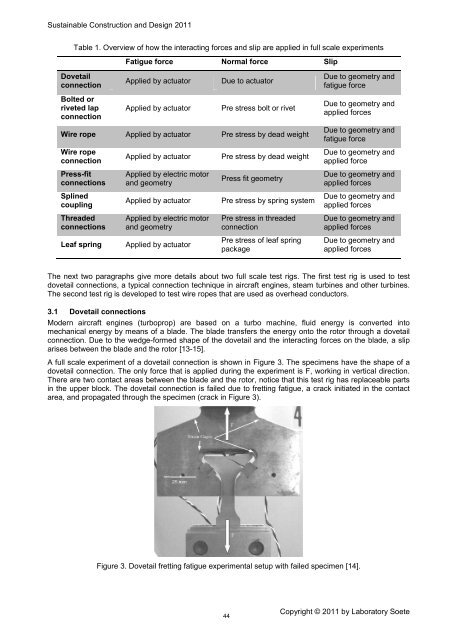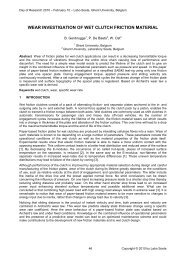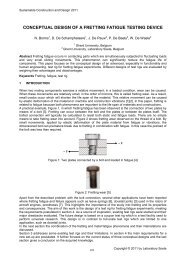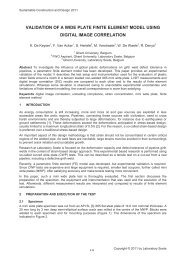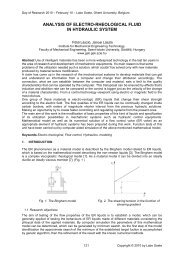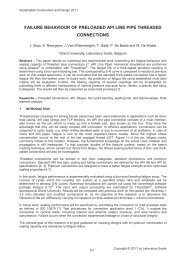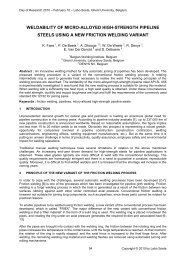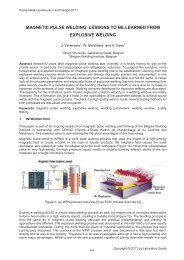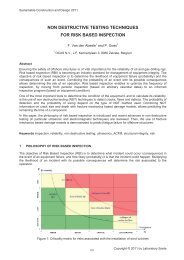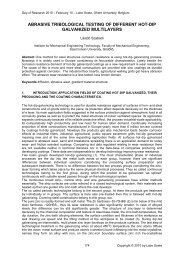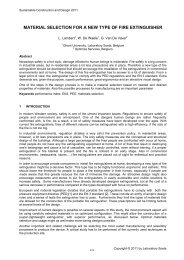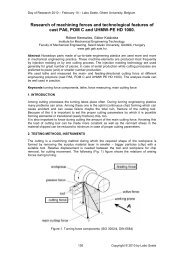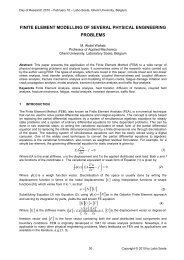Volume 2, Issue 1, 2011, Full Text - 5th International Conference on ...
Volume 2, Issue 1, 2011, Full Text - 5th International Conference on ...
Volume 2, Issue 1, 2011, Full Text - 5th International Conference on ...
Create successful ePaper yourself
Turn your PDF publications into a flip-book with our unique Google optimized e-Paper software.
Sustainable C<strong>on</strong>structi<strong>on</strong> and Design <str<strong>on</strong>g>2011</str<strong>on</strong>g><br />
Table 1. Overview of how the interacting forces and slip are applied in full scale experiments<br />
Fatigue force Normal force Slip<br />
Dovetail<br />
c<strong>on</strong>necti<strong>on</strong><br />
Applied by actuator<br />
Due to actuator<br />
Due to geometry and<br />
fatigue force<br />
Bolted or<br />
riveted lap<br />
c<strong>on</strong>necti<strong>on</strong><br />
Applied by actuator<br />
Pre stress bolt or rivet<br />
Due to geometry and<br />
applied forces<br />
Wire rope Applied by actuator Pre stress by dead weight<br />
Due to geometry and<br />
fatigue force<br />
Wire rope<br />
c<strong>on</strong>necti<strong>on</strong><br />
Applied by actuator<br />
Pre stress by dead weight<br />
Due to geometry and<br />
applied force<br />
Press-fit<br />
c<strong>on</strong>necti<strong>on</strong>s<br />
Applied by electric motor<br />
and geometry<br />
Press fit geometry<br />
Due to geometry and<br />
applied forces<br />
Splined<br />
coupling<br />
Applied by actuator<br />
Pre stress by spring system<br />
Due to geometry and<br />
applied forces<br />
Threaded<br />
c<strong>on</strong>necti<strong>on</strong>s<br />
Applied by electric motor<br />
and geometry<br />
Pre stress in threaded<br />
c<strong>on</strong>necti<strong>on</strong><br />
Due to geometry and<br />
applied forces<br />
Leaf spring<br />
Applied by actuator<br />
Pre stress of leaf spring<br />
package<br />
Due to geometry and<br />
applied forces<br />
The next two paragraphs give more details about two full scale test rigs. The first test rig is used to test<br />
dovetail c<strong>on</strong>necti<strong>on</strong>s, a typical c<strong>on</strong>necti<strong>on</strong> technique in aircraft engines, steam turbines and other turbines.<br />
The sec<strong>on</strong>d test rig is developed to test wire ropes that are used as overhead c<strong>on</strong>ductors.<br />
3.1 Dovetail c<strong>on</strong>necti<strong>on</strong>s<br />
Modern aircraft engines (turboprop) are based <strong>on</strong> a turbo machine, fluid energy is c<strong>on</strong>verted into<br />
mechanical energy by means of a blade. The blade transfers the energy <strong>on</strong>to the rotor through a dovetail<br />
c<strong>on</strong>necti<strong>on</strong>. Due to the wedge-formed shape of the dovetail and the interacting forces <strong>on</strong> the blade, a slip<br />
arises between the blade and the rotor [13-15].<br />
A full scale experiment of a dovetail c<strong>on</strong>necti<strong>on</strong> is shown in Figure 3. The specimens have the shape of a<br />
dovetail c<strong>on</strong>necti<strong>on</strong>. The <strong>on</strong>ly force that is applied during the experiment is F, working in vertical directi<strong>on</strong>.<br />
There are two c<strong>on</strong>tact areas between the blade and the rotor, notice that this test rig has replaceable parts<br />
in the upper block. The dovetail c<strong>on</strong>necti<strong>on</strong> is failed due to fretting fatigue, a crack initiated in the c<strong>on</strong>tact<br />
area, and propagated through the specimen (crack in Figure 3).<br />
Figure 3. Dovetail fretting fatigue experimental setup with failed specimen [14].<br />
44<br />
Copyright © <str<strong>on</strong>g>2011</str<strong>on</strong>g> by Laboratory Soete


